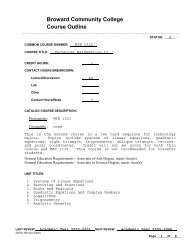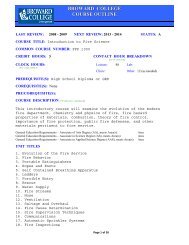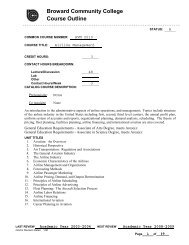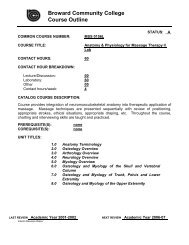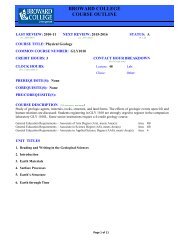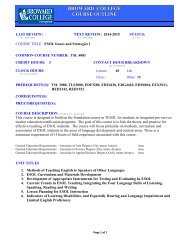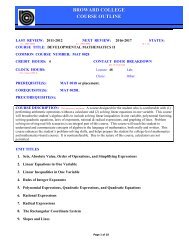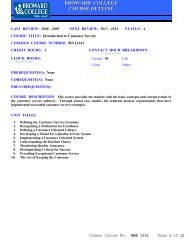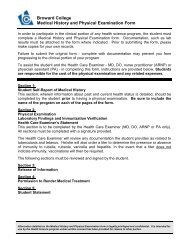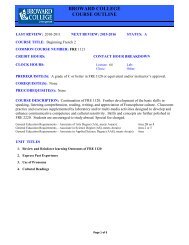QMB2100.pdf - Broward College
QMB2100.pdf - Broward College
QMB2100.pdf - Broward College
You also want an ePaper? Increase the reach of your titles
YUMPU automatically turns print PDFs into web optimized ePapers that Google loves.
BROWARD COLLEGE<br />
COURSE OUTLINE<br />
LAST REVIEW: 2008 - 2009 NEXT REVIEW: 2013 - 2014 STATUS: A<br />
COURSE TITLE: Quantitative Methods in Business<br />
COMMON COURSE NUMBER: QMB2100<br />
CREDIT HOURS: 3<br />
CONTACT HOUR BREAKDOWN<br />
(per 16 week term)<br />
CLOCK HOURS: Lecture: 48 Lab:<br />
(Voc. Course ONLY)<br />
Clinic:<br />
Other:<br />
PREREQUISITE(S): None<br />
COREQUISITE(S): None<br />
PRE/COREQUISITE(S):<br />
COURSE DESCRIPTION:<br />
This course applies quantitative methods to business problems with emphasis on learning to select the<br />
appropriate problem solving method, applying the chosen method, and interpreting the solution. The use of<br />
quantitative methods in managerial decision making is a continuous focus of this course. Management<br />
problems are used and written managerial recommendations are required.<br />
UNIT TITLES<br />
1. Quantitative Applications in Business and Economics<br />
2. Descriptive Quantitative Tools and Approaches<br />
3. Introduction to Probability<br />
4. Sampling and Sampling Distributions<br />
5. Business Hypothesis Testing<br />
6. Experimental Design and Analysis of Variance<br />
7. Simple Linear Regression and Correlations in Business<br />
8. Decision Analysis in Business, Economics, Accounting, Marketing and Management<br />
Common Course No: QMB 2100 Page 1 of 10
BROWARD COLLEGE<br />
COURSE OUTLINE<br />
EVALUATION:<br />
Evaluation may include but is not limited to the following:<br />
Exams, Quizzes, Presentations, Portfolios, Discussions, Class Participation, Attendance, Projects, Co-ops, Practicum,<br />
Internships, Externships, and Research Reports.<br />
*** Complete the following only if course is seeking general education status ***<br />
GENERAL EDUCATION Competencies and Skills *:<br />
Please highlight in green font all Competencies/Skills from the list below that apply to this course. In the box to the right of the<br />
Competency/Skill, enter all specific learning outcome numbers (i.e. 1.1, 2.7, 5.12) that apply.<br />
1. Read with critical comprehension<br />
2. Speak and listen effectively<br />
3. Write clearly and coherently<br />
4. Think creatively, logically, critically, and reflectively<br />
(analyze, synthesize, apply, and evaluate)<br />
5. Demonstrate and apply literacy in its various forms:<br />
(highlight in green ALL that apply)<br />
( 1. technological, 2. informational, 3. mathematical,<br />
4. scientific, 5. cultural, 6. historical, 7. aesthetic and/or<br />
8. environmental )<br />
6. Apply problem solving techniques to real-world<br />
experiences<br />
7. Apply methods of scientific inquiry<br />
8. Demonstrate an understanding of the physical and<br />
biological environment and how it is impacted by<br />
human beings<br />
9. Demonstrate an understanding of and appreciation<br />
for human diversities and commonalities<br />
10. Collaborate with others to achieve common goals.<br />
11. Research, synthesize and produce original work<br />
12. Practice ethical behavior<br />
13. Demonstrate self-direction and self motivation<br />
14. Assume responsibility for and understand the impact<br />
of personal behaviors on self and society<br />
15. Contribute to the welfare of the community<br />
* General Education Competencies and Skills endorsed by ’05-’06 General Education Task Force<br />
Common Course No: QMB 2100 Page 2 of 10
BROWARD COLLEGE<br />
COURSE OUTLINE<br />
Common Course Number: QMB2100<br />
UNITS<br />
Unit 1. Quantitative Application in Business Economics<br />
General Outcome:<br />
1.0 The students should be able to explain the role of quantitative tools in<br />
business in our society and analyze the various quantitative methods.<br />
Specific Learning Outcomes:<br />
Upon successful completion of this unit, the students should be able to:<br />
1.1 Explain the rationale of business quantitative methods in today's society.<br />
1.2 Discuss the importance of quantitative methods and applications in<br />
Accounting, Finance, Marketing, Production and Economics.<br />
1.3 Identify the different methods of data presentation.<br />
1.4 Calculate and measure the different scales of quantitative and qualitative<br />
data.<br />
1.5 Recognize data collections and procedures, source of data, statistical<br />
studies and possible data-acquisition errors.<br />
1.6 Differentiate between descriptive statistics and statistical/quantitative<br />
differences.<br />
Common Course No: QMB 2100 Page 3 of 10
BROWARD COLLEGE<br />
COURSE OUTLINE<br />
Unit 2.<br />
Common Course Number: QMB2100<br />
Descriptive Quantitative Tools and Approaches<br />
General Outcome:<br />
2.0 The students should be able to explain the descriptive quantitative tools and<br />
their approaches to the business world.<br />
Specific Learning Outcomes:<br />
Upon successful completion of this unit, the students should be able to:<br />
2.1 Recognize the importance of frequency distributions, summarizing qualitative<br />
data by relative frequency distribution, bar graphs and pie charts.<br />
2.2 Summarize qualitative data by frequency distribution, relative frequency<br />
distribution, histogram and cumulative relative frequency distribution.<br />
2.3 Explore data analysis by giving business cases.<br />
2.4 Measure the central tendency of both grouped and ungrouped data.<br />
2.5 Recognize the values of the mean as opposed to the median, and mode.<br />
2.6 Synthesize the mean, median and mode into a useful description of a set of<br />
data.<br />
2.7 Recognize the procedures involved in the calculation of the measure of central<br />
tendency of both grouped and ungrouped data.<br />
2.8 Measure the dispersions of both grouped and ungrouped data.<br />
2.9 Recognize the procedures involved in the calculation of fractiles.<br />
2.10 Measure the values of the standard deviation as opposed to the average<br />
deviation.<br />
2.11 Recognize the procedure involved in the calculation of the measures of<br />
dispersion of both grouped and ungrouped.<br />
2.12 Measure normal and abnormal distribution with regard to dispersion and<br />
skewness.<br />
2.13 Synthesize the average deviation, standard deviation and quartile deviation<br />
into a useful description of a set of data.<br />
Page 4 of 10
BROWARD COLLEGE<br />
COURSE OUTLINE<br />
Unit 3.<br />
Introduction to Probability<br />
Common Course Number: QMB2100<br />
General Outcome:<br />
3.0 The students should be able to use probability knowledge to read and<br />
interpret business reports, newspaper and magazine articles and television<br />
commentaries.<br />
Specific Learning Outcomes:<br />
Upon successful completion of this unit, the students should be able to:<br />
3.1 Recognize the concept of probability, discrete probability distribution and<br />
continuous probability distribution.<br />
3.2 Recognize basic probability theory.<br />
3.3 Measure permutations and combinations.<br />
3.4 Apply permutations.<br />
3.5 Assign probabilities to experimental outcomes by classical methods.<br />
3.6 Apply combinations.<br />
3.7 Measure the binomial distribution.<br />
3.8 Measure the proportional distribution under the normal curve.<br />
3.9 Measure the proportional distribution under the normal curve.<br />
3.10 Recognize sampling methods for statistical analysis.<br />
3.11 Recognize the Central Limit Theorem.<br />
Page 5 of 10
BROWARD COLLEGE<br />
COURSE OUTLINE<br />
Unit 4.<br />
Common Course Number: QMB2100<br />
Sampling and Sampling Distribution<br />
General Outcome:<br />
4.0 The students should be able to develop and select the appropriate method to<br />
solve a business problem to apply the chosen method and to interpret the<br />
solutions(s).<br />
Specific Learning Outcomes:<br />
Upon successful completion of this unit, the students should be able to:<br />
4.1 Recognize the procedures used in establishing sample sizes.<br />
4.2 Recognize and apply the techniques known as Null Hypothesis Testing.<br />
4.3 Analyze the difference between tow means, both large and small samples.<br />
4.4 Recognize Type I and Type II errors.<br />
4.5 Analyze the difference between tow proportions, both large and small samples.<br />
Page 6 of 10
BROWARD COLLEGE<br />
COURSE OUTLINE<br />
Unit 5.<br />
Hypothesis Testing<br />
Common Course Number: QMB2100<br />
General Outcome:<br />
5.0 The students should be able to demonstrate to hypothesize the research topic<br />
either to accept the decision or to reject the alternatives in the real business<br />
world.<br />
Specific Learning Outcomes:<br />
Upon successful completion of this unit, the students should be able to:<br />
5.1 Develop null and alternative hypotheses in decision making.<br />
5.2 Develop research hypotheses and text the validity of assumptions.<br />
5.3 Interpret one-sample hypothesis testing for means and percentages.<br />
5.4 Interpret two-sample hypotheses testing for means and percentages.<br />
Page 7 of 10
BROWARD COLLEGE<br />
COURSE OUTLINE<br />
Unit 6.<br />
Common Course Number: QMB2100<br />
Experimental Design and Analysis of Variances<br />
General Outcome:<br />
6.0 The students should be able to design research topics by using experimental<br />
tools and analysis of variances in business related topics.<br />
Specific Learning Outcomes:<br />
Upon successful completion of this unit, the students should be able to:<br />
6.1 Measure business decisions by data collection and design considerations.<br />
6.2 Analyze variance procedure for completely randomized designs.<br />
6.3 Develop ANOVA table.<br />
Page 8 of 10
BROWARD COLLEGE<br />
COURSE OUTLINE<br />
Unit 7.<br />
Common Course Number: QMB2100<br />
Simple Linear Regression and Correlation in Business<br />
General Outcome:<br />
7.0 The students should be able to demonstrate an understanding of the simple<br />
relationship between and among the business decision variable and to<br />
interpret the meaning and significance of coefficient of correlation between<br />
them.<br />
Specific Learning Outcomes:<br />
Upon successful completion of this unit, the students should be able to:<br />
7.1 Recognize and understand simple regression analysis.<br />
7.2 Recognize the least square methods.<br />
7.3 Measure and understand regression model and its basic assumptions.<br />
7.4 Measure and understand the coefficient of correlations.<br />
7.5 Test the significance of a coefficient of correlation.<br />
7.6 Interpret co-variance and coefficient of correlation from the regression<br />
analysis.<br />
7.7 Develop forecasting models.<br />
Page 9 of 10
BROWARD COLLEGE<br />
COURSE OUTLINE<br />
Unit 8.<br />
Common Course Number: QMB2100<br />
Decision Analysis in Business, Economics, Accounting, Marketing and Management<br />
General Outcome:<br />
8.0 The students should be able to differentiate quantitative methods used in<br />
business decision making, how to select the most appropriate one, how to<br />
apply it, and how to make interpretations of the solution.<br />
Specific Learning Outcomes:<br />
Upon successful completion of this unit, the students should be able to:<br />
8.1 Recognize decision theory as applied to business decisions in the selection of<br />
alternatives.<br />
8.2 Develop decision matrix tables with different payoffs.<br />
8.3 Develop decision trees with different payoffs.<br />
8.4 Develop decision making without probabilities.<br />
8.5 Develop decision making with probabilities.<br />
8.6 Develop expected value of sample information.<br />
8.7 Recognize the concepts of linear programming, waiting lines and simulation.<br />
Page 10 of 10



